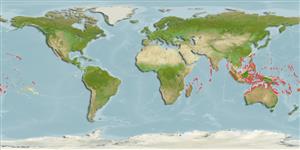Common names from other countries
Environment: milieu / climate zone / depth range / distribution range
Ecologia
marinhas associadas(os) a recifes; não migratória; intervalo de profundidade 0 - 20 m (Ref. 9710), usually 2 - 15 m (Ref. 37816). Tropical; 26°N - 25°S
Indo-Pacific: East Africa to Mangaréva, Tuamoto Islands and the Hawaiian Islands, north to Taiwan; throughout Micronesia.
Tamanho / Peso / Idade
Maturity: Lm ? range ? - ? cm
Max length : 8.5 cm SL macho/indeterminado; (Ref. 9710)
Espinhos dorsais (total) : 10; Raios dorsais (total) : 12; Espinhos anais: 3; Raios anais : 6. Irregular dark bars on body which may be broken into spots; 2 narrow diagonal bars on cheek; opercle and base of soft dorsal with large ocellated black spot (Ref. 5469).
A secretive species remaining in or near interstices of rock, coral, or rubble (Ref. 2334, 58302). Moderately common in seaward reefs in areas exposed to moderate surge or currents (Ref. 2334). Feeds on small crustaceans (Ref. 89972). Benthic (Ref. 58302). Minimum depth reported from Ref. 30874.
Ciclo de vida ou comportamento de acasalamento
Maturities | Reprodução | Spawnings | Egg(s) | Fecundities | Larvas
Randall, J.E., G.R. Allen and R.C. Steene, 1990. Fishes of the Great Barrier Reef and Coral Sea. University of Hawaii Press, Honolulu, Hawaii. 506 p. (Ref. 2334)
Status na Lista Vermelha da UICN (Ref. 130435)
CITES (Ref. 128078)
Not Evaluated
Ameaça para os humanos
Harmless
Uso pelos humanos
Pescarias: espécies comerciais; Aquário: Espécies comerciais
Ferramentas
Relatórios especiais
Baixar XML
Fontes da internet
Estimates based on models
Preferred temperature (Ref.
115969): 25.2 - 29.3, mean 28.4 (based on 2558 cells).
Índice de diversidade filogenética (Ref.
82804): PD
50 = 0.5312 [Uniqueness, from 0.5 = low to 2.0 = high].
Bayesian length-weight: a=0.01585 (0.00637 - 0.03944), b=3.01 (2.79 - 3.23), in cm Total Length, based on LWR estimates for this (Sub)family-body shape (Ref.
93245).
Nível Trófico (Ref.
69278): 3.5 ±0.6 se; based on size and trophs of closest relatives
Fishing Vulnerability (Ref.
59153): Low vulnerability (10 of 100).
